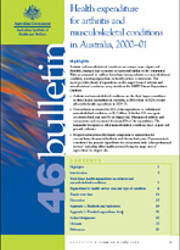Highlights
Arthritis and musculoskeletal conditions are a major cause of pain and disability, placing a high economic and personal burden on the community. With an estimated 6.1 million Australians having arthritis or a musculoskeletal condition, resulting expenditure on health services is substantial. This report provides details of expenditure on five major forms of arthritis and musculoskeletal conditions, using data from the AIHW Disease Expenditure Database.
- Arthritis and musculoskeletal conditions are the third largest contributor to direct health expenditure in Australia, at $4.6 billion or 9.2% of total allocatable health expenditure in 2000-01.
- Osteoarthritis accounted for 26% of the expenditure on arthritis and musculoskeletal conditions, at $1.2 billion. A further 12% was spent on chronic back pain and 6% on slipped disc. Rheumatoid arthritis and osteoporosis each accounted for around 5% of the expenditure. The remainder was spent on other musculoskeletal conditions (such as gout and juvenile arthritis).
- Hospital services were the largest component of expenditure for osteoarthritis, rheumatoid arthritis and chronic back pain. Pharmaceuticals constituted the greatest expenditure for osteoporosis, with 'other professional services' (including allied health services) being the major area of expenditure for slipped disc.
- On average, real (inflation-adjusted) health expenditure on arthritis and musculoskeletal conditions increased by 4.3% annually between 1993-94 and 2000-01. This is a smaller rate of increase than the overall average annual increase in real health expenditure in Australia over this period.
- The annual increases in expenditures on out-of-hospital medical services and pharmaceuticals were greater for arthritis and musculoskeletal conditions than for the health system as a whole.
Since arthritis and musculoskeletal conditions become more common with age, the burden associated with them is likely to increase as the Australian population ages. This may lead to greater health expenditure on these conditions in the future.



